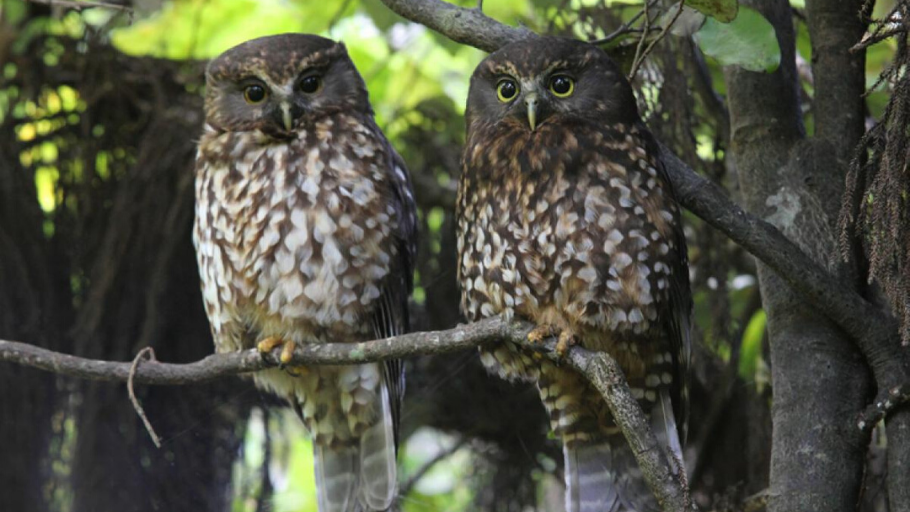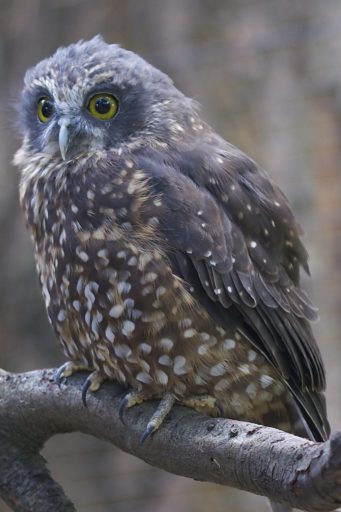The rūrū is Aotearoa’s last remaining native owl. It’s not considered a threatened species. In fact, it’s reasonably common and widespread, especially in forested parts of the North Island and western South Island.
But rūrū do tend to nest in tree cavities, which puts females at risk from introduced mammal predators. That’s a good reason to keep tabs on rūrū numbers to ensure they’re doing okay. So how do you monitor a nocturnal and well camouflaged species like rūrū without spending all night out in the forest?

Automatic recording devices (ARDs) might well be the answer and researchers Moira Pryde, James Mortimer, Terry Greene and Helene Thygesen from the Department of Conservation have been investigating the optimal monitoring times to deploy them for rūrū.
“There is an increasing need to develop robust species monitoring methods for quantifying outcomes of pest management. Internationally, owls have been shown to be useful indicators of ecosystem health. As birds of prey, they are at risk via secondary poisoning from any toxins within an ecosystem. As cavity nesters they are vulnerable to nest predation and are therefore a good indicator of the efficacy of predator management.”
Their study was carried out in Fiordland, with additional data obtained from other locations across New Zealand.
“We wanted to determine the optimal time(s) of night and month(s) of the year for monitoring rūrū using ARDs, to enable development of a robust monitoring method that maximises probability of detection. Fourteen ARDs were placed at 500 m intervals throughout a 400-ha forest block in the Eglinton Valley, Fiordland, New Zealand, and the presence of rūrū recorded monthly from August 2011 to March 2012. Data from the Department of Conservation’s national Tier 1 Monitoring Programme (2011–2016), gathered from multiple locations across public conservation land, were also analysed to provide broader context.”

Nocturnal and hard to see, detection of rūrū is dependent on hearing their distinctive calls. But season, time of night and weather can all affect the frequency of calling. A Nelson study back in 1980 showed, for example, the rūrū preferred clear or cloudy nights and were less inclined to call when it was raining or frosty.
The ARDs used in the study were custom designed and developed by the Department of Conservation (DOC).
“Each device consisted of a water-resistant aluminium tube containing a programmable microprocessor, power source and digital data storage. Four water-resistant microphones were covered with wind noise-dampening foam and housed within a protective wire-mesh cage. The microphones were linked to a low noise pre-amplifier with a DSP anti-aliasing filter. As most rūrū calls are discernible at low frequencies the devices were set to record in the 0–4 kHz range. Operational life using four AA batteries (NiMh rechargeable) was approximately 100 hours.”
Sound files were recorded as 15 minute files (in .WAV format) and were processed manually by four experienced ornithologists using the software Freebird 2013.
“Both at the Eglinton Valley and across New Zealand public conservation and, rūrū calls were detected in all months surveyed and during all periods of the night. Detection probability (derived from call activity) was generally higher in the North Island and the west coast of the South Island.”
The researchers recorded seasonal differences in call activity in different parts of New Zealand.
“At the Eglinton Valley the highest call activity occurred in December, with activity in spring generally higher than in summer. On public conservation land, calling activity was highest in spring and early summer and lowest in late summer.”
The time of night when calling peaked also varied at the different locations.
“Patterns in how call activity changed throughout the night varied from month to month in the Eglinton Valley. Across New Zealand, public conservation land (for all months), the call activity peaked approximately 1 hour after sunset then steadily declined throughout the remainder of the night.”
So there’s no blanket answer about when to set your automatic recording device to detect rūrū calling. It depends to some extent on your location, but the researchers do make some recommendations.
“Our results and those of previous studies indicate general patterns of calling activity but with local variation. We recommend that, as a general rule, detection probability can be maximised by carrying out rūrū monitoring surveys in the spring or early summer, during the first few hours after sunset. However, we also recommend an initial study of the site(s) to investigate local variations in call activity before any long-term monitoring is initiated.”
While ARDs offer an effective way to monitor nocturnal species such as rūrū, the researchers admit that the time-consuming task of then manually analysing the data is a limiting factor
“ARDs provide an effective and relatively efficient alternative to traditional observer-based monitoring techniques. The ability to collect data from multiple locations simultaneously from dusk until dawn is an obvious advantage of these devices. At present, however, a major limitation is the time it takes to convert audio recordings into usable data. Currently this is achieved by manually processing recordings by visually scanning sonograms and listening to potential bird vocalisations.”
This becomes even more difficult if rūrū are only rarely heard at a site.
“Within the Eglinton Valley, one or two nights of data for each ARD station per month was considered sufficient to generate presence/absence data. However, rūrū are relatively common at this site, and at sites where they are less common additional nights may be required to determine the actual presence of this species. This could result in many additional processing hours which may be beyond the financial budget of some monitoring programmes.”
Automated species identification offers some hope for future monitoring, however.
“There has been much recent research into automated species identification to improve processing efficiency. Complete or even partial automation, would allow a larger number of recordings to be processed more quickly, producing a larger sample and improved confidence in results of analyses. Unfortunately, at the time of our study such techniques were not sufficiently developed.”
The full research report is published in the New Zealand Journal of Ecology and is freely available online.
Optimising monitoring times for surveys of rūrū (Ninox novaeseelandiae novaeseelandiae) (2020)

